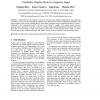Free Online Productivity Tools
i2Speak
i2Symbol
i2OCR
iTex2Img
iWeb2Print
iWeb2Shot
i2Type
iPdf2Split
iPdf2Merge
i2Bopomofo
i2Arabic
i2Style
i2Image
i2PDF
iLatex2Rtf
Sci2ools
INTERACT
2003
2003
Candidate Display Styles in Japanese Input
: Typing Japanese into computers consists of typing Roman alphabet, displaying the kana character, converting kana to kanji, and selecting the intended kanji character from a list of homophonic candidates. This paper presents a study of four candidate display styles, three commonly used in commercial products (“vertical,” “horizontal,” and “compact-horizontal”) and one novel (“matrix”), together with various manual selection methods (mouse, numeric key, spacebar, cursor key, numeric keypad and unrestricted input method). The results show that (1) when typing a single kanji character, about 70% of total operation time is spent on choice selection; and (2) the “compact-horizontal” and “matrix” display styles are superior to the other display styles.
| Added | 31 Oct 2010 |
| Updated | 31 Oct 2010 |
| Type | Conference |
| Year | 2003 |
| Where | INTERACT |
| Authors | Xiangshi Ren, Kinya Tamura, Jing Kong, Shumin Zhai |
Comments (0)

